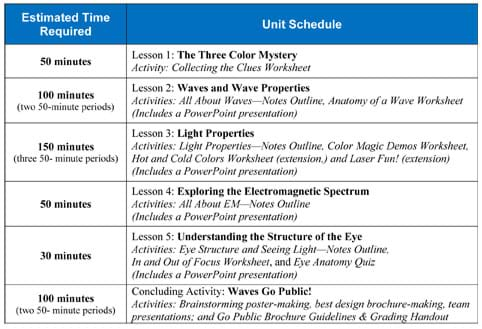
Summary
Students are presented with a challenge question concerning color blindness and asked to use engineering principles to design devices to help people who are color blind. Using the legacy cycle as a model, this unit is comprised of five lessons designed to teach wave properties, the electromagnetic spectrum, and the anatomy of the human eye in an interactive format that introduces engineering applications and real-world references. It culminates with an activity in which student teams apply what they have learned to design devices that can aid people with colorblindness in distinguishing colors— as evidenced by their creation of brainstorming posters, descriptive brochures and short team presentations, as if they were engineers reporting to clients. Through this unit, students become more aware of the connections between the biology of the eye and the physical science concept of light, and gain an understanding of how those scientific concepts relate to the field of engineering.Engineering Connection
Engineers use the properties of waves in the design of everyday tools. Rearview mirrors, x-ray machines, and microwaves are examples of technologies that rely on an understanding of waves. When engineers work with ophthalmologists and optometrists to design eyeglasses, as another example, they apply their knowledge of light waves to the interactions light has with human eyes, so that they can customize solutions for individual deficiencies. Engineers of all disciplines employ the steps of the engineering design process in order to create innovative, effective and efficient solutions to human challenges.
Educational Standards
Each TeachEngineering lesson or activity is correlated to one or more K-12 science,
technology, engineering or math (STEM) educational standards.
All 100,000+ K-12 STEM standards covered in TeachEngineering are collected, maintained and packaged by the Achievement Standards Network (ASN),
a project of D2L (www.achievementstandards.org).
In the ASN, standards are hierarchically structured: first by source; e.g., by state; within source by type; e.g., science or mathematics;
within type by subtype, then by grade, etc.
Each TeachEngineering lesson or activity is correlated to one or more K-12 science, technology, engineering or math (STEM) educational standards.
All 100,000+ K-12 STEM standards covered in TeachEngineering are collected, maintained and packaged by the Achievement Standards Network (ASN), a project of D2L (www.achievementstandards.org).
In the ASN, standards are hierarchically structured: first by source; e.g., by state; within source by type; e.g., science or mathematics; within type by subtype, then by grade, etc.
See individual lessons and activities for standards alignment.
Subscribe
Get the inside scoop on all things TeachEngineering such as new site features, curriculum updates, video releases, and more by signing up for our newsletter!Unit Schedule

More Curriculum Like This

Students apply everything they have learned over the course of the associated lessons about waves, light properties, the electromagnetic spectrum, and the structure of the eye, by designing devices that can aid color blind people in distinguishing colors. They create posters to display their three d...

Students learn about the anatomical structure of the human eye and how humans see light, as well as some causes of color blindness. They conduct experiments as an example of research to gather information.

Students examine the structure and function of the human eye, learning some amazing features about our eyes, which provide us with sight and an understanding of our surroundings. Students also learn about some common eye problems and the biomedical devices and medical procedures that resolve or help...
Copyright
© 2013 by Regents of the University of Colorado; original © 2010 Clemson UniversityContributors
Ellen Zielinski; Courtney Faber; Marissa H. Forbes, through Clemson University's "Engineering Fibers and Films Experience – EFF-X" Research Experience for Teachers Program, National Science Foundation grant no. EEC-0602040Supporting Program
Research Experience for Teachers (RET) Program, Center of Advancement of Engineering Fibers and Films, Clemson UniversityAcknowledgements
This unit was developed through Clemson University's "Engineering Fibers and Films Experience – EFF-X" Research Experience for Teachers program, funded by National Science Foundation grant no. EEC-0602040. However, these contents do not necessarily represent the policies of the National Science Foundation, and you should not assume endorsement by the federal government.
Last modified: January 12, 2019






User Comments & Tips